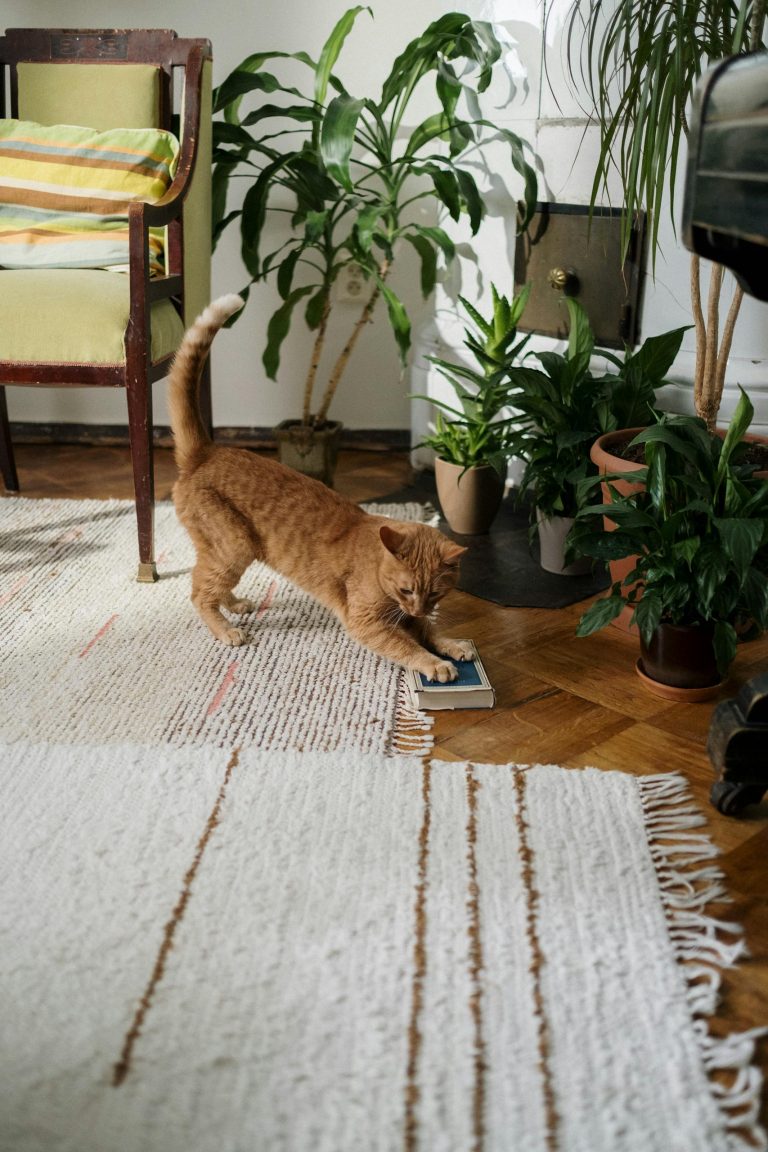9 stunning pink indoor plants anyone can care (& where to buy!)
Explore our curated list of best pink indoor plants that are easy to care, grown in our Brooklyn community home. Discover the care and maintenance tips, along with how to keep their leaves pink and thriving all year long!
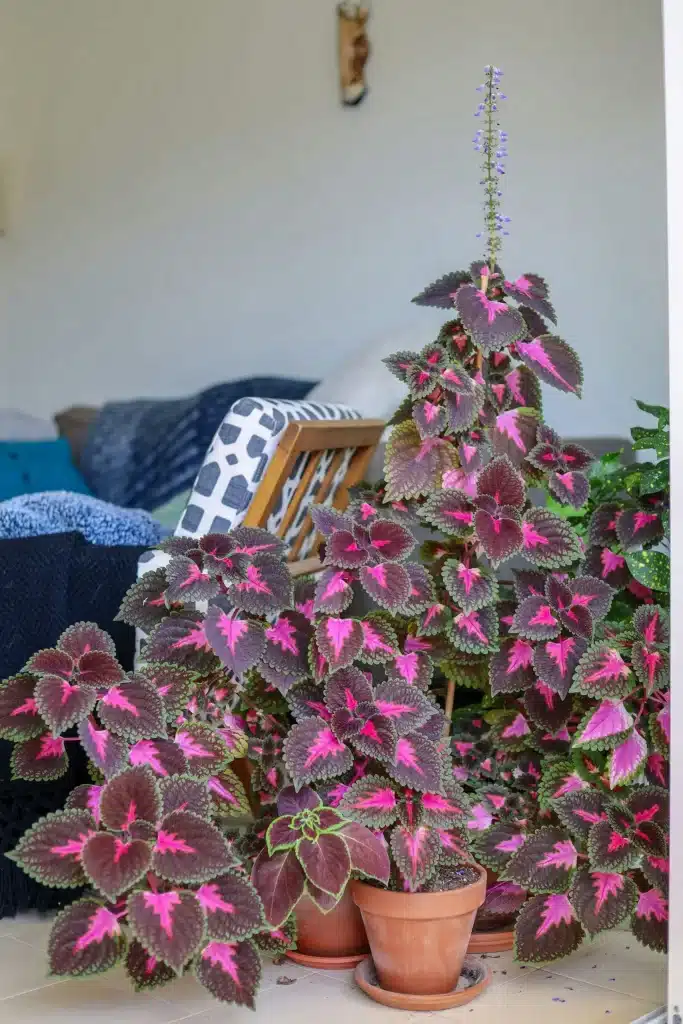
When you purchase through links on our site, we may earn an affiliate commission, which helps sustain our blog!
Pink-hued foliage instantly uplifts your mood and adds a particular touch of exotic beauty to your space. In our Brooklyn community home, we’ve curated a collection of the most stunning pink indoor plants that adorn the sunny windowsills and cozy corners of our seven bedrooms. There are particular ways we have learnt to keep the leaves of these plants pink and thriving, and we can’t wait to share the list, and their care tips.
According to a study by the Journal of Physiological Anthropology, interaction with indoor plants can significantly reduce stress and enhance overall well-being, proving that these vibrant pink plants are more than just decorative.
In this article, we’ll guide you through:
Let’s dive in.
Summary:
What are the best Pink Indoor Plants?
Pink Chinese Evergreen, Pink Calathea, Pink Tradescantia, Pink Princess Philodendron, Christmas Cactus, Pink Orchids, are some of the best pink indoor plants anyone can grow. They need low effort & thrive in typical home conditions.
Snapshot of our Top 5 picks (Swipe Left)
Pink chinese evergreen

Pink Calathea
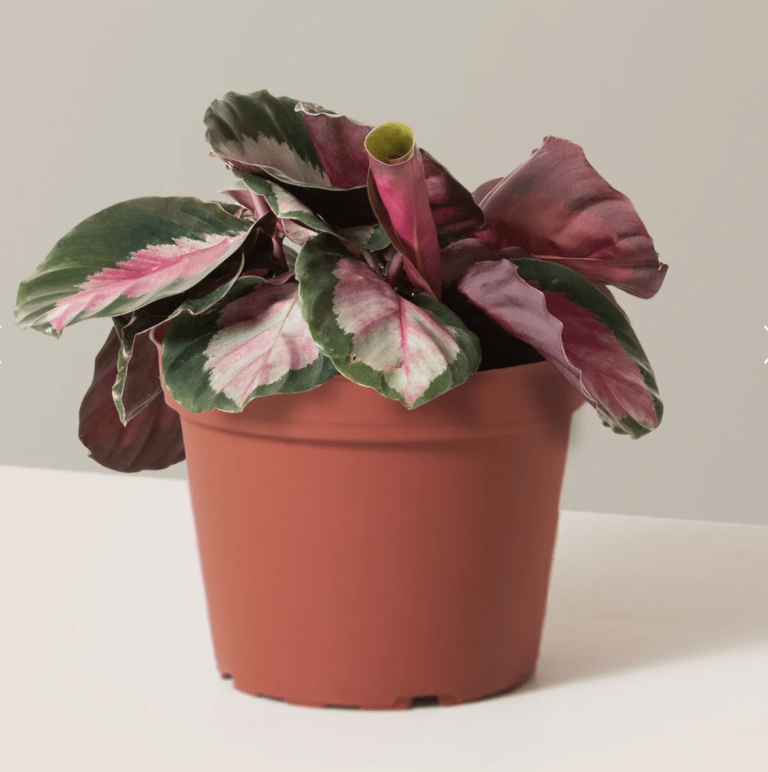
3. Pink tradescantia

Pink princess philodendron
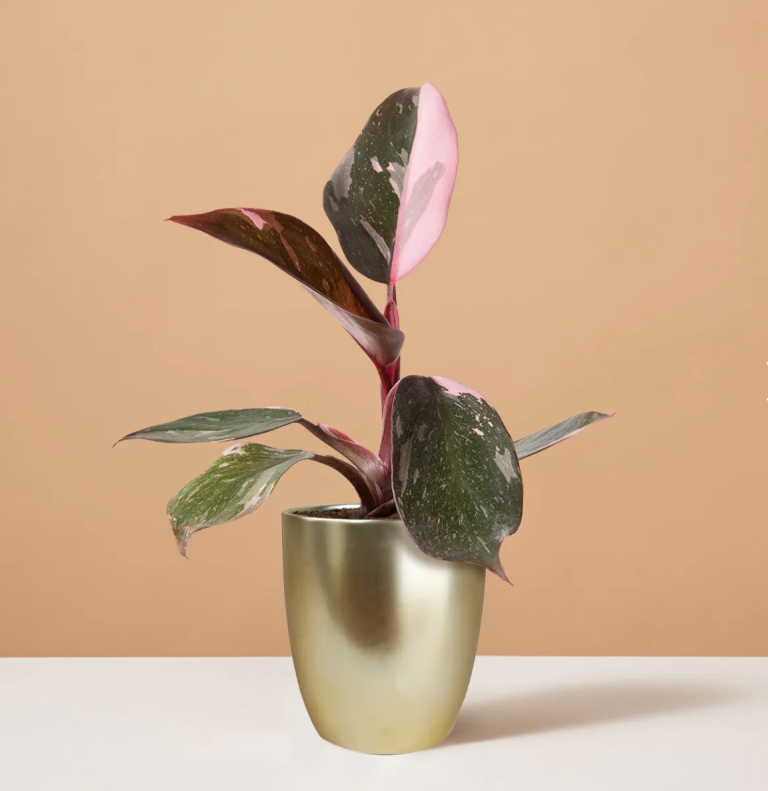
Christmas cactus
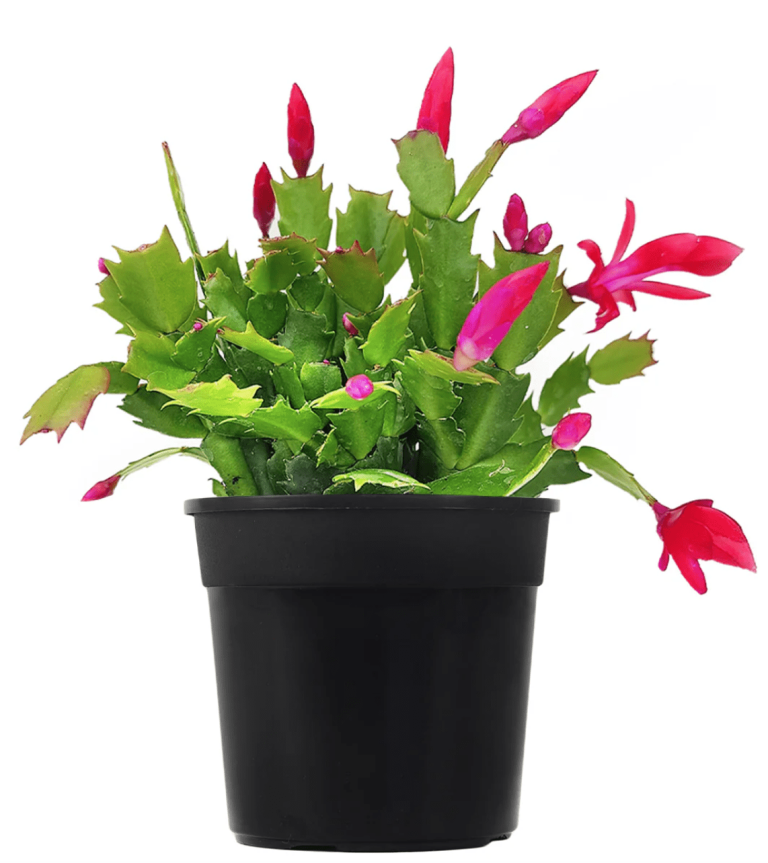
Best indoor plants that have pink and green leaves
1. Pink Chinese evergreen

Mildly toxic
Low to bright light
Grows upto 3 feet
Any windows
mildly toxic
low light
grows to 3 feet
Any windows
The Pink Chinese Evergreen (aka Aglaonema): This pink indoor plant, part of the Araceae family has vibrant, sprawling and welcoming pink leaves We have placed ours in the top floor north facing room, where it thrives in low to medium light and adds a pop of color! Styled in a contemporary beige ceramic pot, it enhances the room’s modern look, and complements the pink hues of the leaves!
Care tip:
- Thrives in low to medium. Water every 1-2 weeks.
- Watch for yellowing leaves that can indicate overwatering.
- If the leaves are silver or white, put it in a brighter spot.
Propagation tip:
- Cut a healthy stem with at least 5-6 inches and a few leaves.
- Place the cutting in water with the cut end submerged.
- Keep in bright, indirect light. Roots will develop in 2-3 weeks.
Symbolism and zodiac signs:
- The Chinese Evergreen symbolizes longevity and good fortune — ideal for Pisces who appreciate its calming presence and easy care.
Pros and cons

($43)

($58)

($29)
$27
“Love the pink leaves! This plant is very hardy and doesn’t require much maintenance” – Amazon customer
2. Rex Begonia
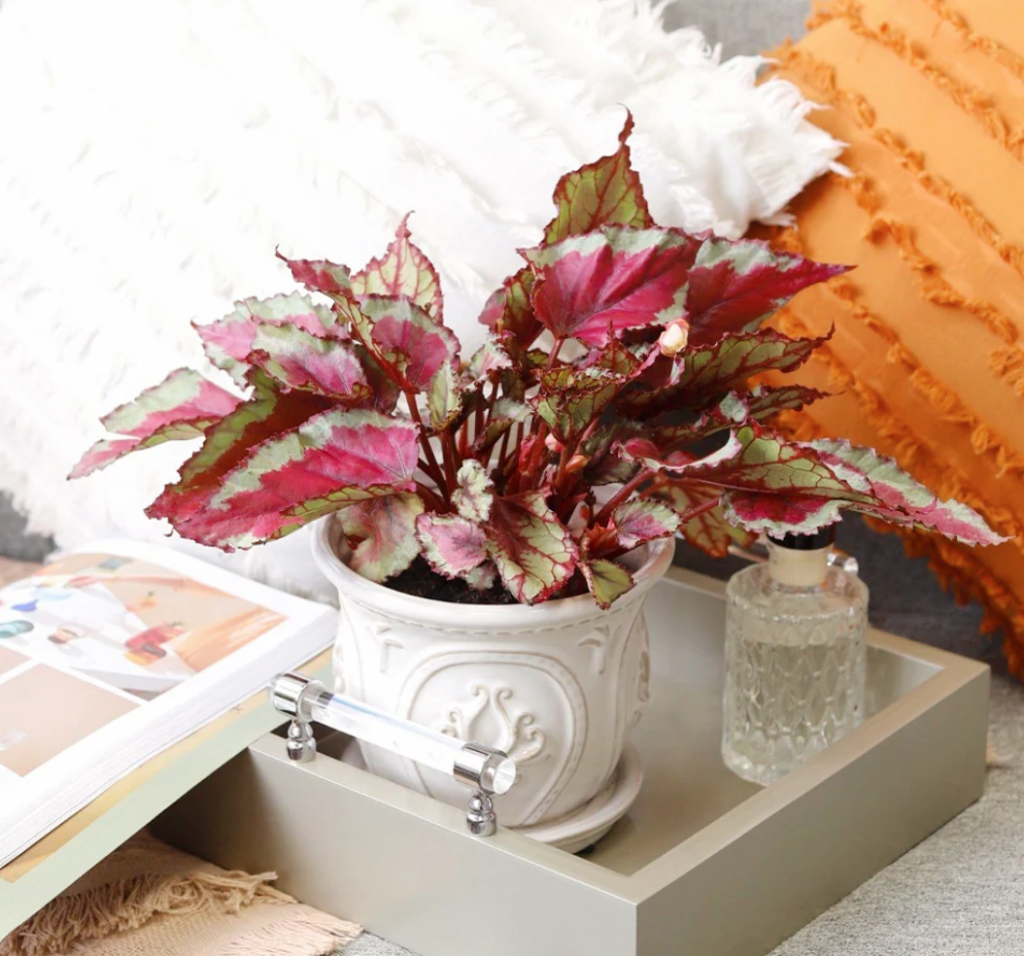
Mildly toxic
Bright light
Grows upto 2 feet
East/South windows
mildly toxic
Bright light
grows to 2 feet
East/South facing windows
The Begonia (aka Begonia spp.), a member of the Begoniaceae family, has asymmetrical leaves that come in a variety of shapes and colors. We’ve found that our begonia thrives best in bright, indirect light, so we have placed it on our windowsill in our our east-facing reading room.
They also bloom with charming clusters of small flowers in shades of pink, white, or red! Begonias can grow to about 1 to 2 feet tall!
Read also: Our favorite pots and planters specially for pink houseplants
Care tip:
- Begonias prefer bright, indirect light and should be watered when the top inch of soil is dry, typically every 5-7 days.
- Ensure good drainage to prevent root rot, and watch for powdery mildew as a sign of high humidity.
- Avoid getting leaves wet to keep them healthy
Propagation tip:
- Cut a 4-6 inch healthy stem below a leaf node, place it in water.
- Ensure the node is submerged, and change the water every few days.
- Roots will appear in 2-4 weeks.
Symbolism and zodiac signs:
- Begonias symbolize individuality and creativity, and they are most apt for the artistic and nurturing nature of Pisces
Pros and cons

($43)

($24)

($23)
$22
“Its vibrant blooms are stunning!”
3. Pink calathea (rosy)
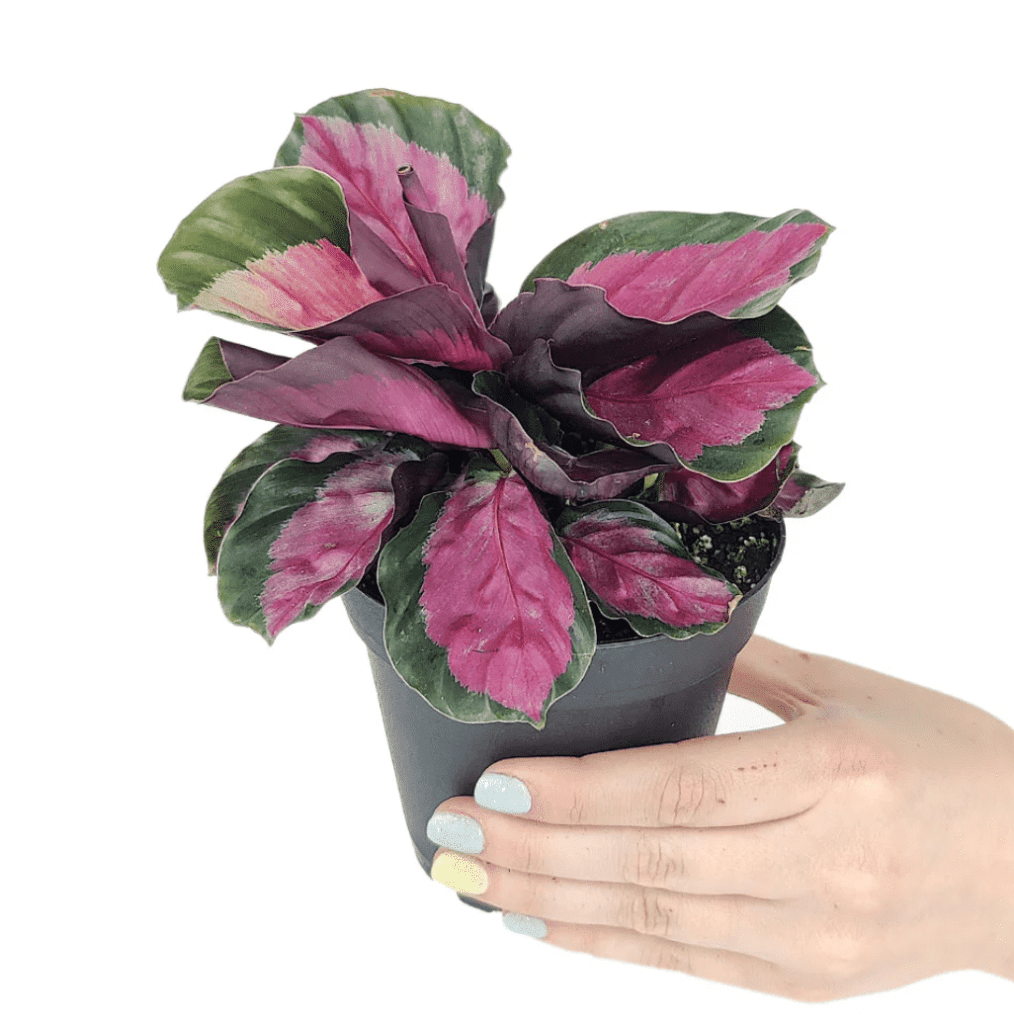
Pet safe
low light
Grows upto 3 feet
East/north windows
Pet safe
low light
grows to 3 feet
East/north facing windows
The pink calathea (rosy) Plant is from the Marantaceae family. This low light houseplant is a true eye-catcher. Each leaf looks like a piece of art, a blend of green, white, and purple patterns that resemble a peacock’s feathers. We have placed our Calathea Plant in a beautiful ceramic planter that highlights its vibrant leaves. It grows up to 2 feet tall, and though it’s safe for pets, it does require high humidity and consistent watering to keep its foliage looking its best!
Read also: care and styling tips for purple calathea
Care tip:
- Water it when the top inch of soil feels dry, usually once a week, and maintain high humidity by misting regularly or using a humidifier.
- Watch for curling or browning leaf edges, which indicate it needs more humidity.
- Keep it in a warm spot away from drafts and AC and heaters please!
Propagation tip:
- Divide the root clump during repotting, ensuring each division has several leaves and roots.
- Plant the divisions in well-draining soil and keep them in indirect light with high humidity.
- New growth should appear within a few weeks. Water propagation is not recommended for this plant!
Symbolism and zodiac signs:
- Symbolizes renewal and creativity, making it a perfect match for Pisces, who are known for their artistic and nurturing nature.
Pros and cons

($58)
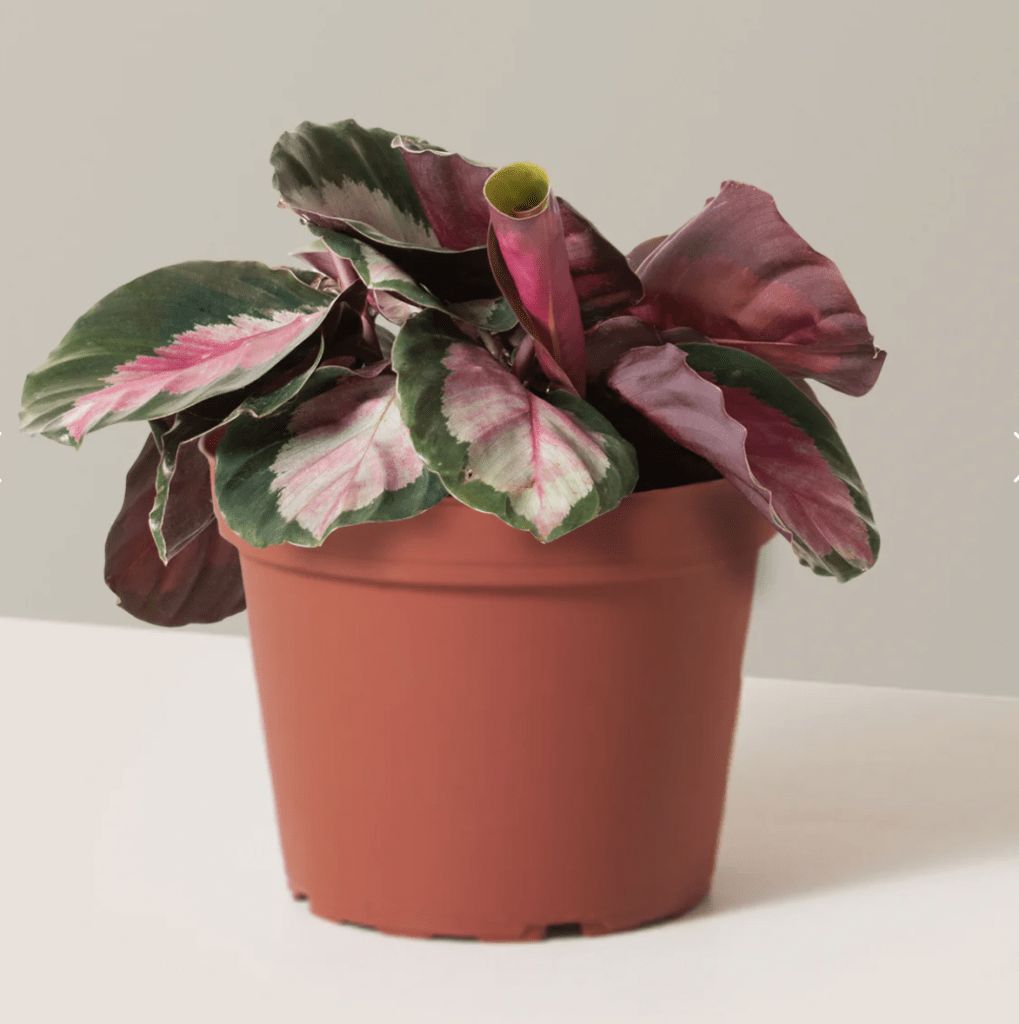
($78)

($20)
$24
“The Calathea is stunning with its vibrant patterns. It does require a bit more humidity but it’s worth it.”
4. Tradescantia (pink)
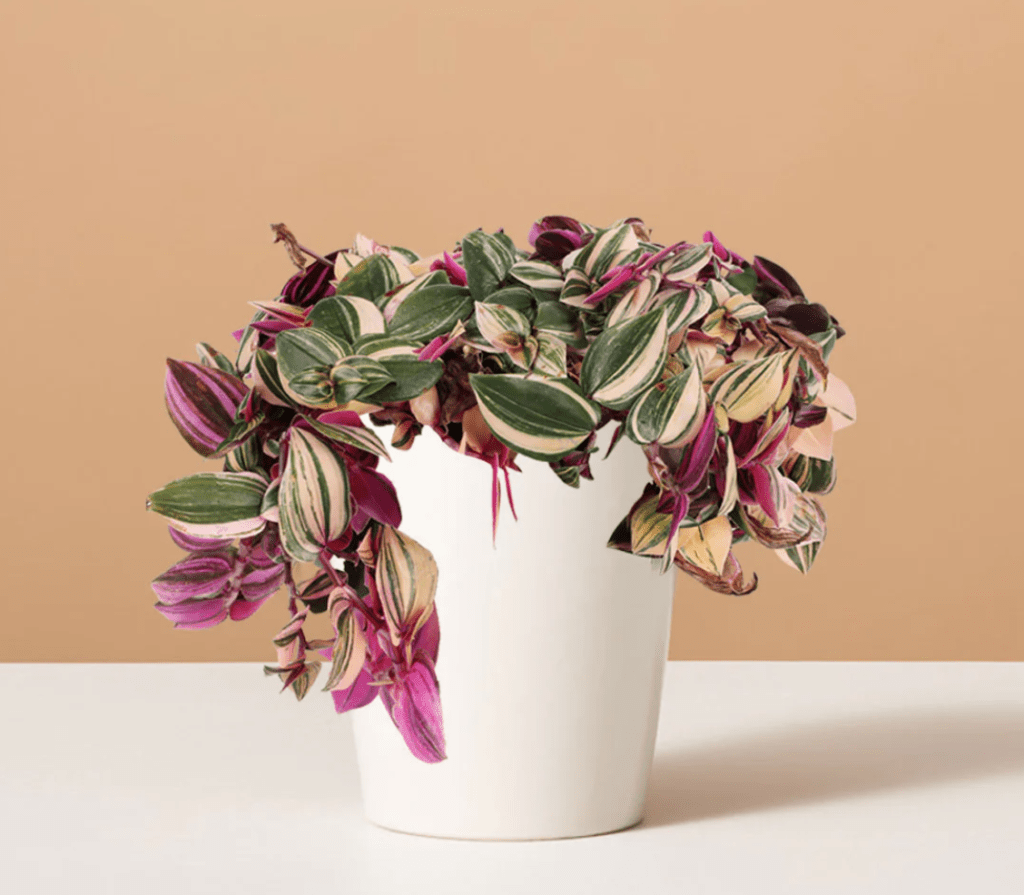
Mildly toxic
low light
Grows upto 4 feet
East/north windows
Mildly toxic
low light
grows to 4 feet
East/north facing windows
The Tradescantia (aka Tradescantia zebrina), a member of the Commelinaceae family, and is a striking addition to any home with its elongated, oval leaves displaying mesmerizing stripes of pink and purple! We’ve placed ours in a hanging planter with other pink and purple vining plants to showcase its trailing vines!
Read also: Care and styling types for Tradescantia Bubblegum
Care tip:
- Tradescantia thrives in any light conditions, and needs watering once the top inch of soil feels dry, usually weekly.
- Ensure good drainage to avoid root rot. Watch for leggy growth, a sign it needs more light.
- Regularly pinch back stems to promote bushiness
Propagation tip:
- Cut a 4-6 inch healthy stem below a leaf node, remove the bottom leaves, and place it in water, ensuring the node is submerged.
- Change the water weekly; roots will appear in 1-2 weeks, then plant in well-draining soil.
Symbolism and zodiac signs: Tradescantia symbolizes resilience and growth, most apt for the nurturing nature of Cancer.
Pros and cons
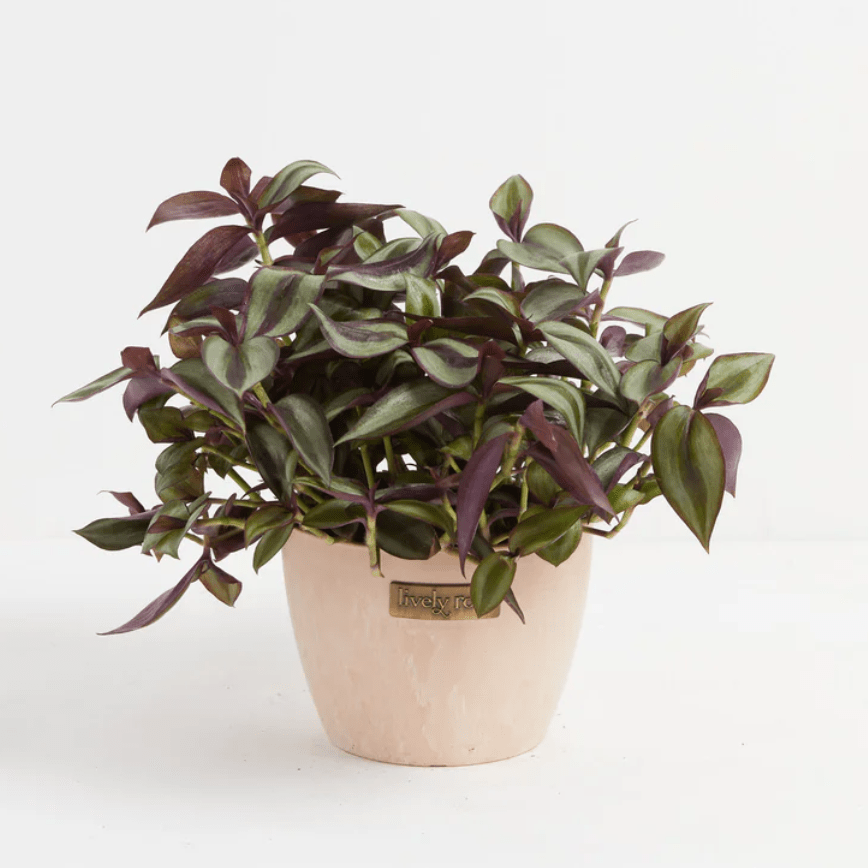
($43)
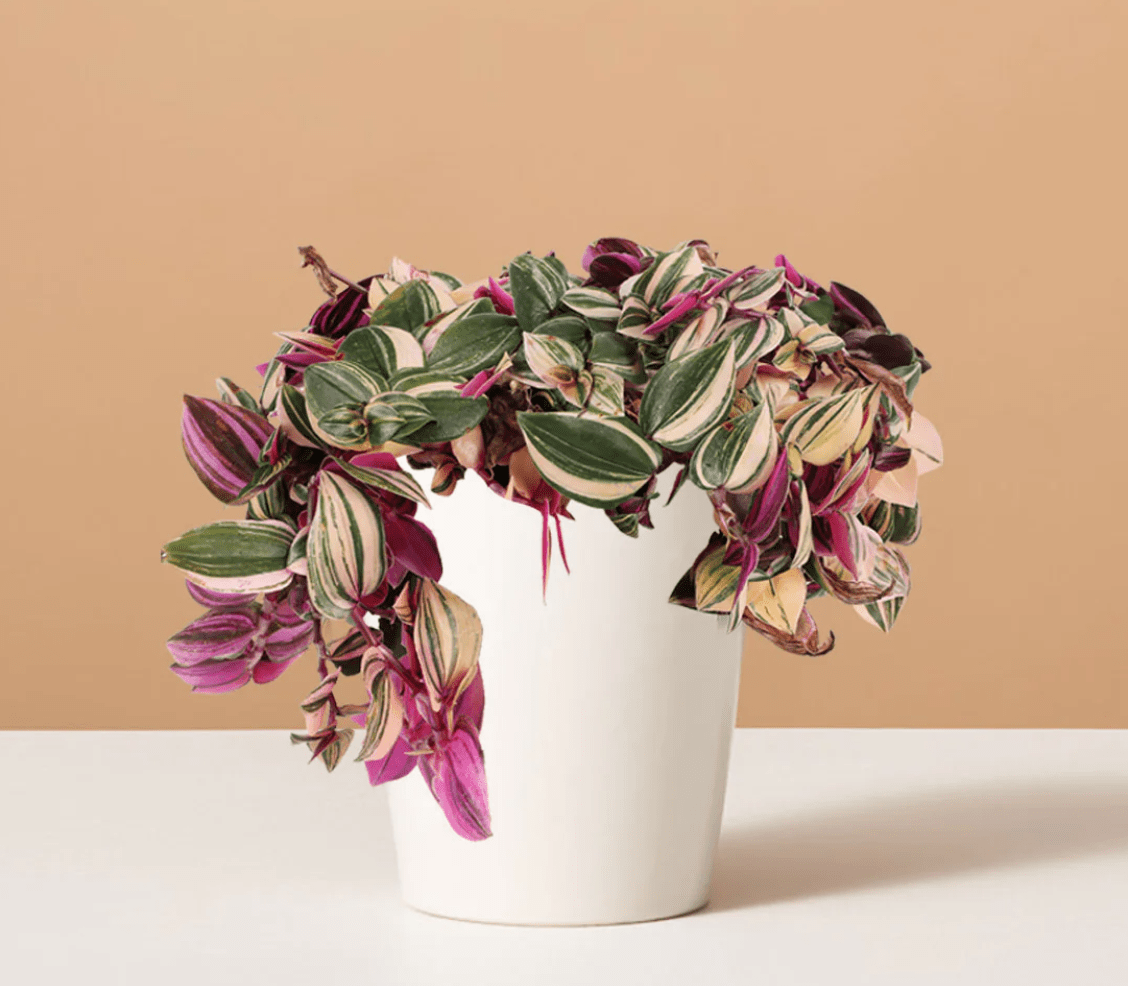
($68)
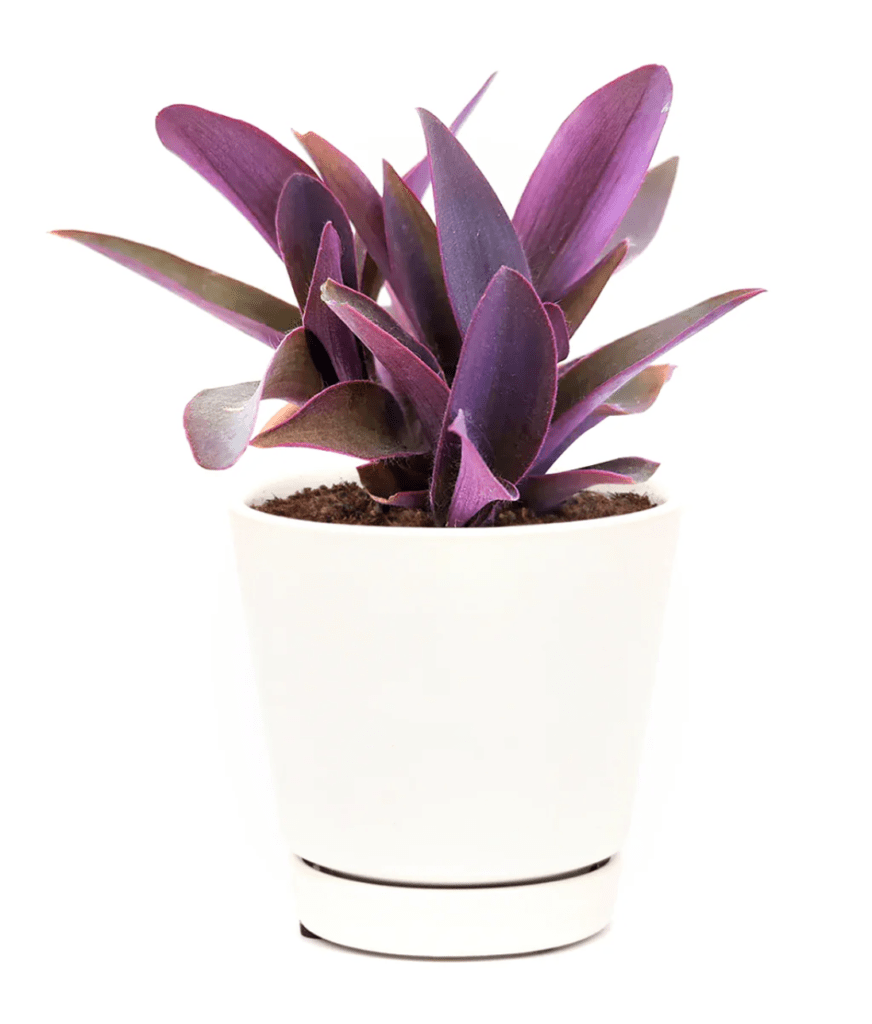
($19)
$11
“It thrives in various lighting conditions and the fast growth rate is incredibly satisfying” – Amazon Customer
5. Pink Princess Philodendron

Mildly toxic
low/Medium light
Grows upto 5 feet
East/north windows
mildly toxic
low light
grows to 5 feet
East/north facing windows
The Pink princess Philodendron (aka Philodendron spp.): This pink trailing houseplant, a member of the Araceae family, has heart-shaped, glossy pink leaves with green hues. This plant is both stylish and functional – we have placed ours in the east-facing reading room, right next to its cousin with green leaves, where it thrives in bright, indirect light.
Its vines cascade around the top of the window frames that add a super inviting dynamic element to the room, and when mature, this Philodendron can trail or climb, growing up to 5 plus feet!
Care tip:
- Thrive in bright, indirect light — need watering when the top inch of soil is dry. Avoid direct sunlight to prevent leaf burn .
- They’re low-maintenance — don’t let the furry animals ingest the leaves.
Propagation tip:
- Cut a 6-inch stem with at least one node, place it in water until roots are 1-2 inches long (about 4-6 weeks), then transplant into well-draining soil
Symbolism and zodiac signs:
- Often associated with health and growth — it is well-suited for Pisces for their nurturing and caring nature
Pros and cons

($43)

($68)

($30)
$32
“Philodendron Brasil is stunning and easy to care for. It’s growing beautifully and quickly!”
Best indoor plants that have pink flowers
1. Christmas cactus
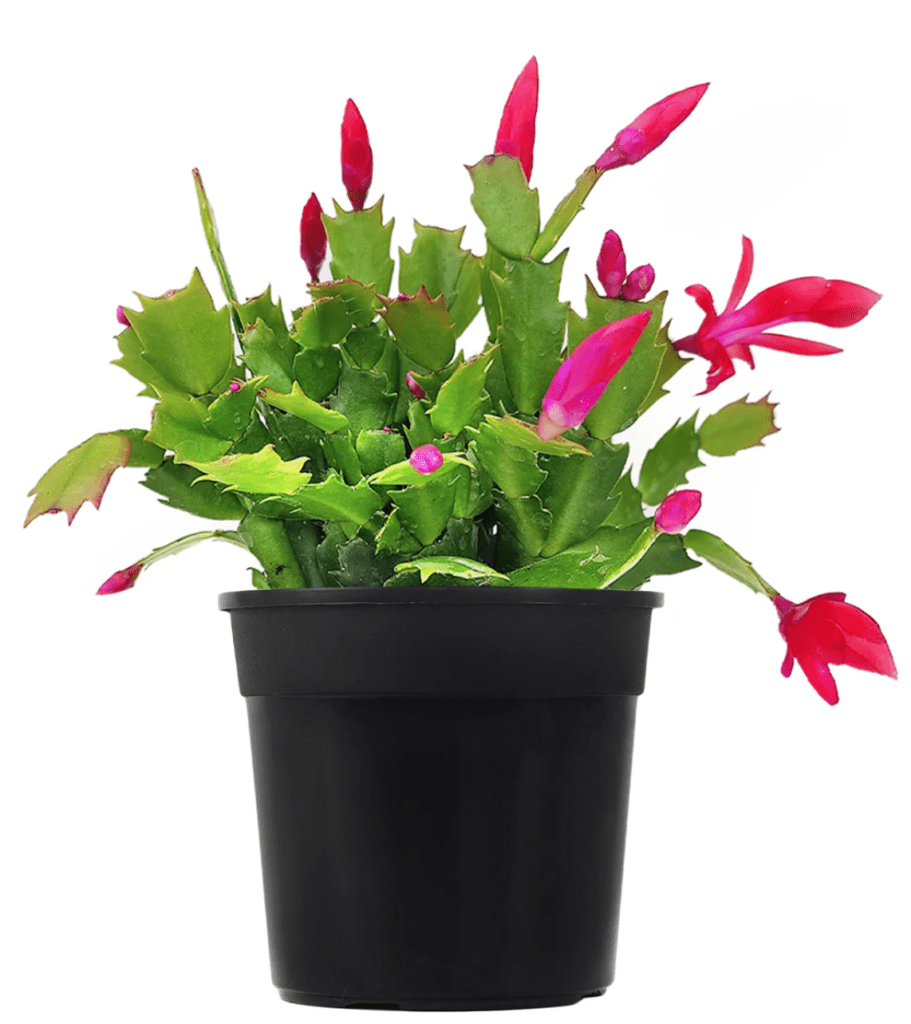
Pet safe
Medium light
Grows upto 2 feet
East/west windows
Pet safe
low light
grows to 3 feet
East/north facing windows
Meet the Christmas Cactus (aka Schlumbergera), a member of the Cactaceae family that is cherished not just for its resilience but also for its spectacular winter blooms. This flowering houseplant has flat, segmented leaves that burst into vibrant pink or red flowers during the cooler months.
We’ve placed our Christmas Cactus in a ceramic hanging planter in the west-facing living room, where it receives bright, indirect light. As it matures, the Christmas Cactus can extend over the edges of its pot, which makes its cascading form particularly attractive in hanging displays. Its blooms last for months as well!
Read also: White Christmas cactus care and styling
Care tip:
- Water typically every 2 to 3 weeks, depending on the humidity in your home.
- To encourage blooming, place it in a cooler spot (about 50-65°F) during the fall.
- Watch for drooping leaves, which usually indicate under-watering.
- This plant prefers a slight drop in temperature at night and during its blooming period in the winter, so adjusting your room temperature accordingly can enhance its vibrant displays.
Propagation tip:
- Snip a segment of 2-3 joined segments from a healthy stem, and allow the cut to dry for a few hours to form a callus.
- Place the segment about an inch deep in a moistened mix of half potting soil and half sand.
- Keep it in indirect light and maintain slight soil moisture. Roots typically develop in 4-6 weeks
Symbolism and zodiac signs:
- Symbolizes purity and rebirth, making it particularly fitting for Scorpios, who are known for their resilience and capacity for transformation.
Pros and cons

($9)
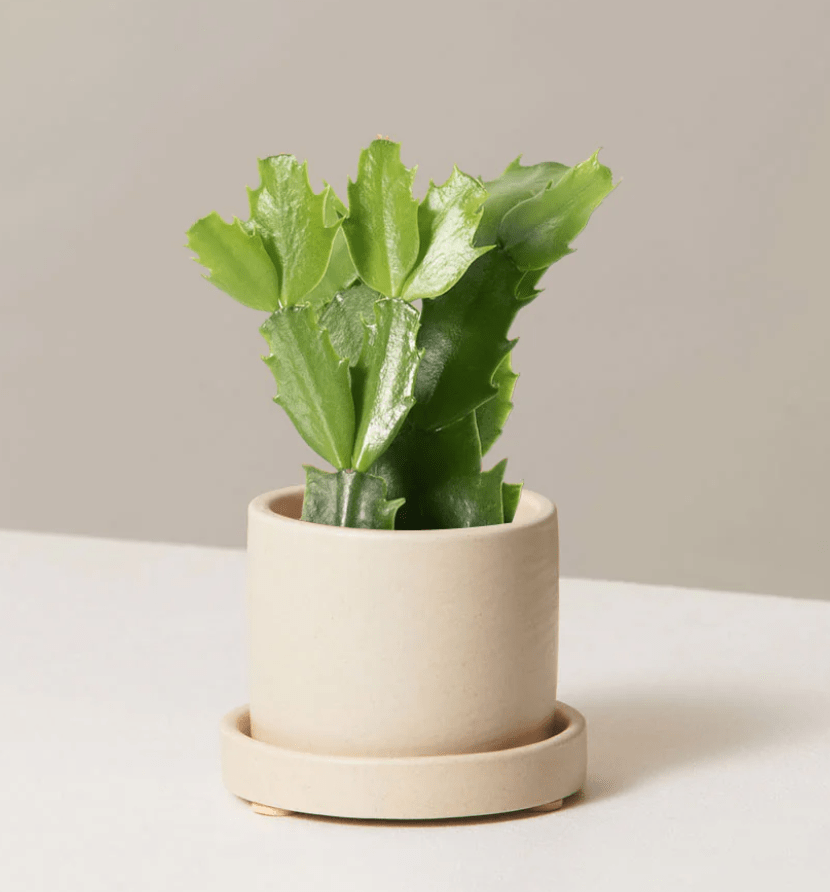
($38)
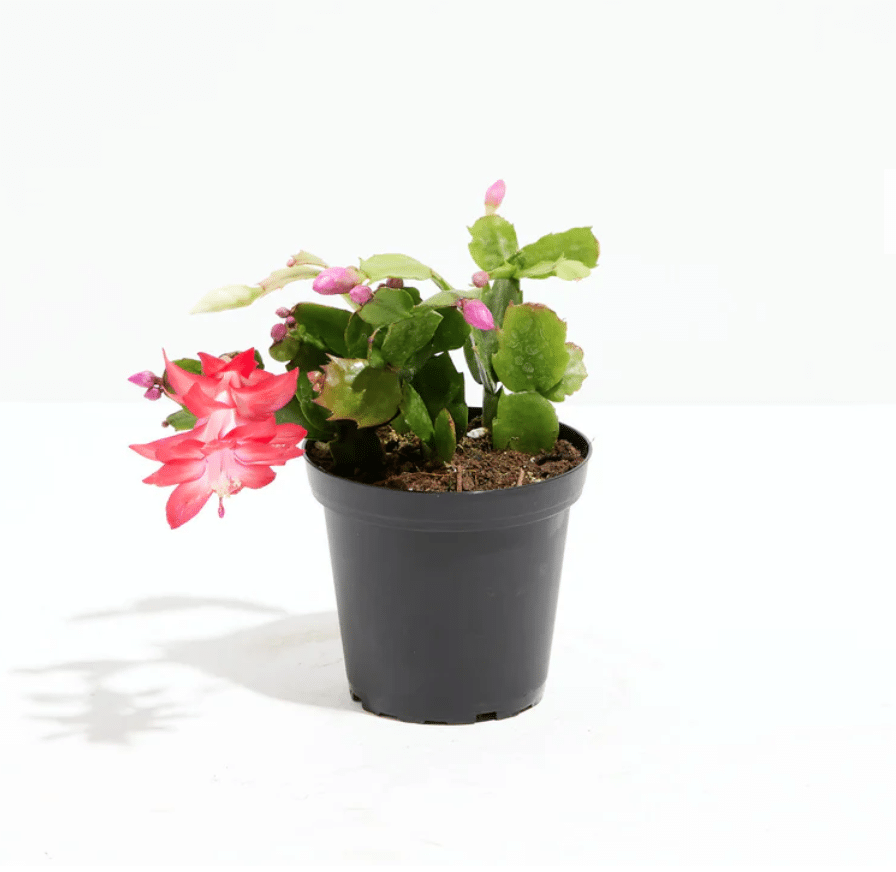
($43)
$9
“it adds a festive touch to my space every year without fail! like signalling winter..”
2. Pink anthurium
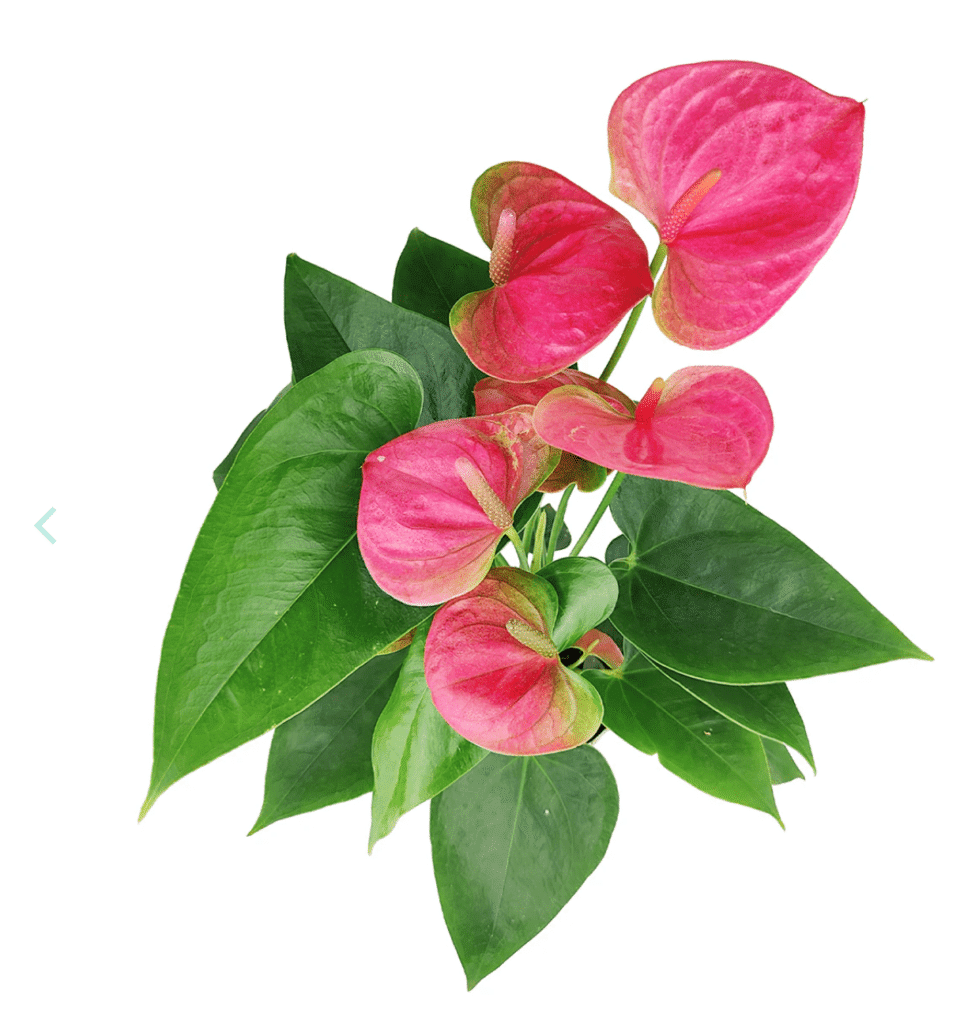
Toxic
Bright light
Grows upto 2 feet
East/South windows
Toxic
Bright light
grows to 2 feet
East/South facing windows
Meet the striking Anthurium (aka Anthurium andraeanum), part of the Araceae family. This pink flowering houseplant is known for its glossy, heart-shaped leaves and vibrant, waxy spathes ranging from deep red to pink and white. These spathes surround the true flowers which are tiny and line the central spadix. They bloom throughout the year.
We have placed our Anthurium in a ceramic cachepot in the west-facing living room. While its bright spathes add a pop of color, the plant is toxic when ingested, so it’s best kept away from pets and children. When mature it grows up to 2 feet!
Read also: White Anthurium care and styling
Care tip:
- Water them once the top inch of soil feels dry, typically every week or so, depending on your home’s humidity.
- Keep the humidity high around the plant; misting or a humidity tray can help.
- Watch for yellowing leaves, which often indicate overwatering, and ensure good drainage to prevent root rot.
Propagation tip:
- Select a healthy stem with about 2-3 inches containing aerial roots.
- Place the stem in a glass of water, ensuring that the roots are submerged.
- Change the water weekly to keep it fresh. Once new roots grow to about an inch long, which typically takes about 3-4 weeks, plant the stem in a pot with well-draining potting soil.
Symbolism and zodiac signs:
- Symbolizes hospitality and happiness, making it an ideal plant for Libras, who are known for their harmonious and welcoming nature
Pros and cons
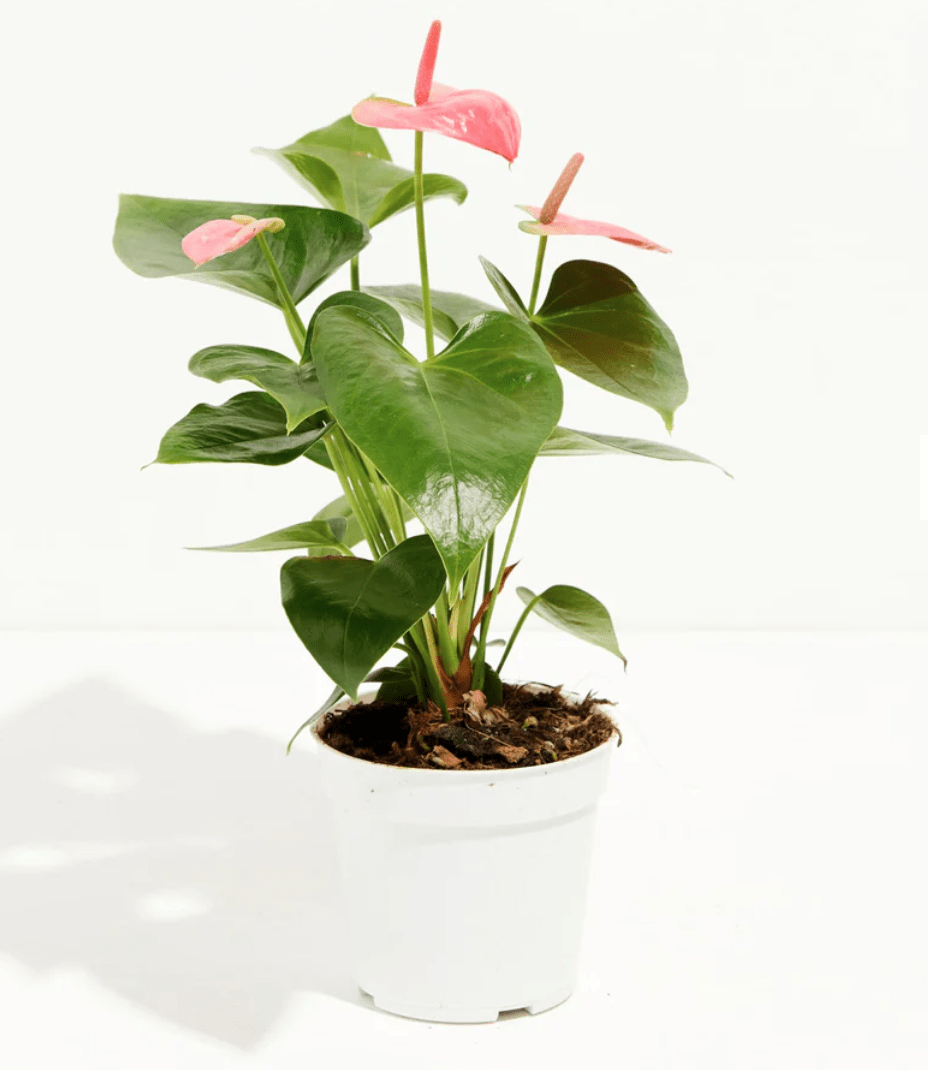
($43)
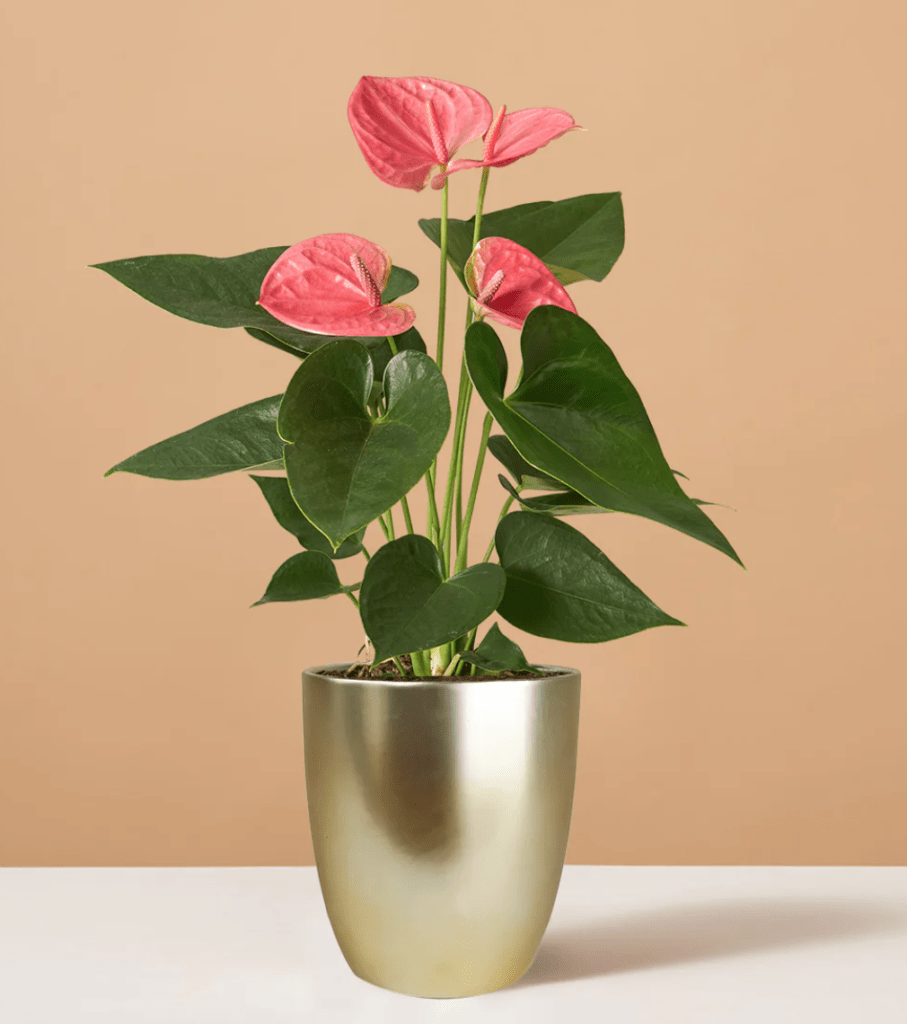
($78)

($23)
$22
“My pink anthurium in so thriving so beautiful, i don’t really have to water it more than once in two weeks! But it worked better when I put it in more light.” – TheSill customer
3. Pink Bromeliad
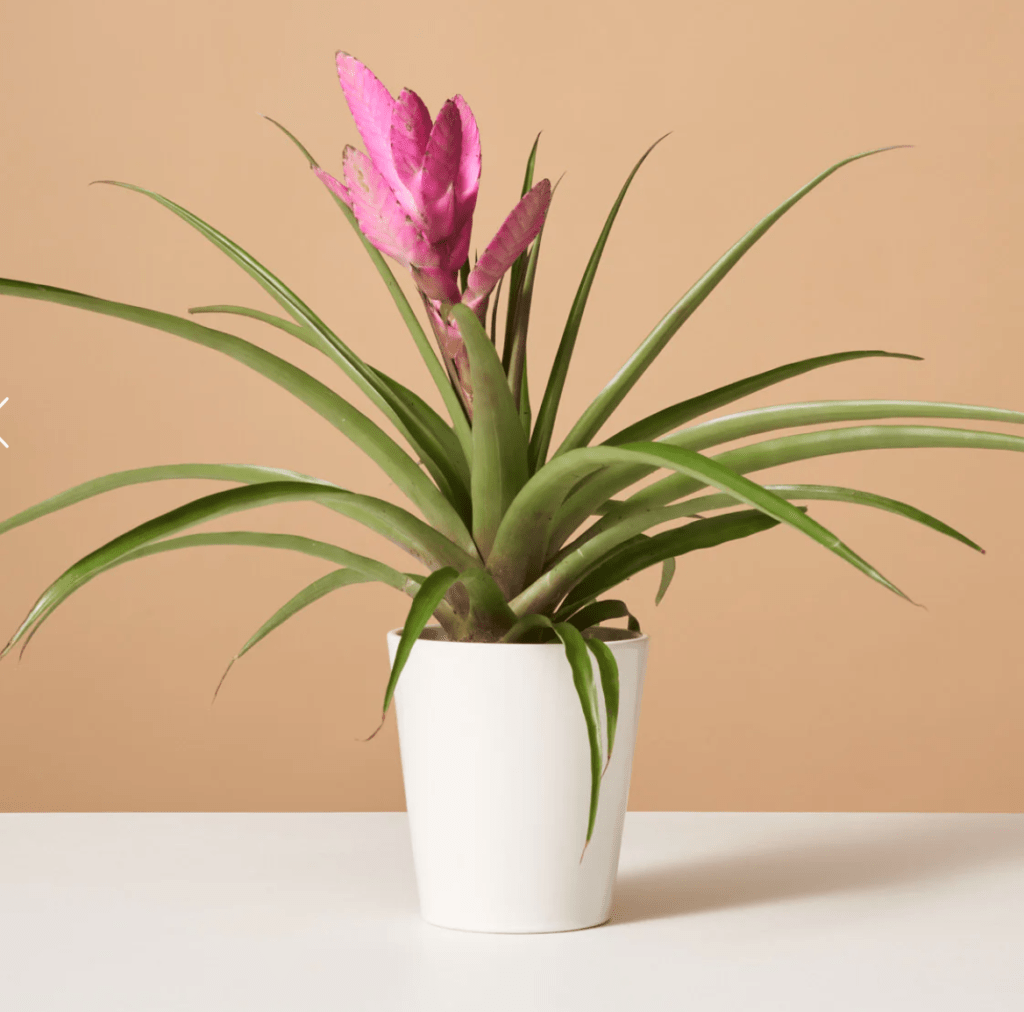
Pet safe
low/Medium light
Grows upto 3 feet
East/West windows
Pet safe
low light
grows to 3 feet
East/West facing windows
The Bromeliad (aka Bromeliaceae) is a striking flowering houseplant that belongs to the Bromeliaceae family. This can be a perfect addition to your bedroom, or to your office desk for its with soothing pink colors, and its compact growth. This plant boasts rosettes of stiff, spiny-edged leaves that form a central cup that is often filled with water.
One of its most captivating features is its flower that emerges from the center and can last several months!! We have placed it in our east-facing reading room where it receives indirect light and have styled in a ceramic planter. When mature, Bromeliads can reach up to 3 feet tall and wide!
Care tip:
- Water your Bromeliad every 1-2 weeks. Central cup should be filled but not stagnant. –
- Place it in indirect light – an east-facing room. Watch for signs of dryness, like browning leaf tips, and ensure good air circulation to prevent rot.
- Bromeliads thrive on high humidity, so mist occasionally
Propagation tip:
- Wait until the “pups” (offsets) are at least one-third the size of the parent plant, then carefully cut them off with a sterilized knife.
- Place the pups in a well-draining mix of half orchid bark and half potting soil.
- It typically takes 2-3 months for the pups to establish roots. Propagation in water is not recommended for this one!
Symbolism and zodiac signs:
- Symbolizes resilience and uniqueness, making it a great match for the determined and resourceful Scorpio
Pros and cons
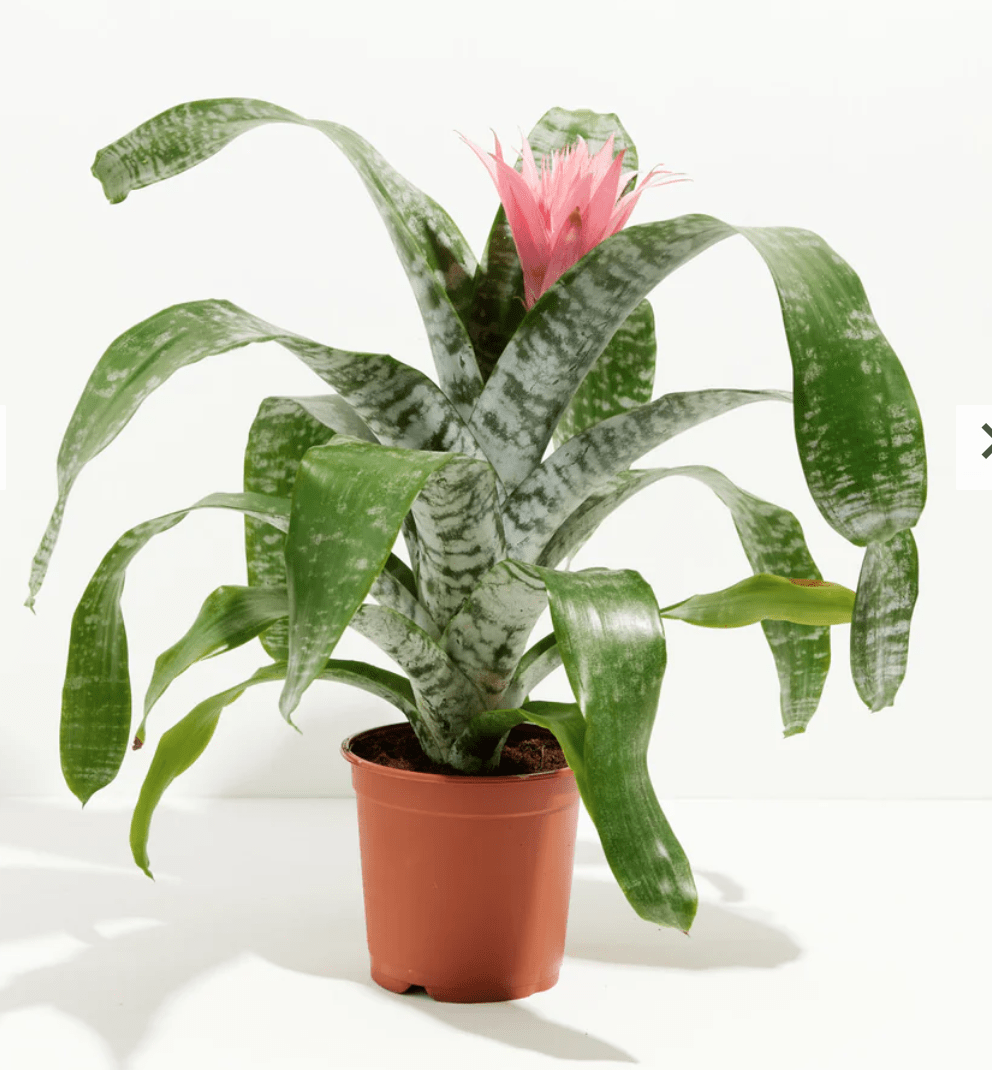
($58)

($78)
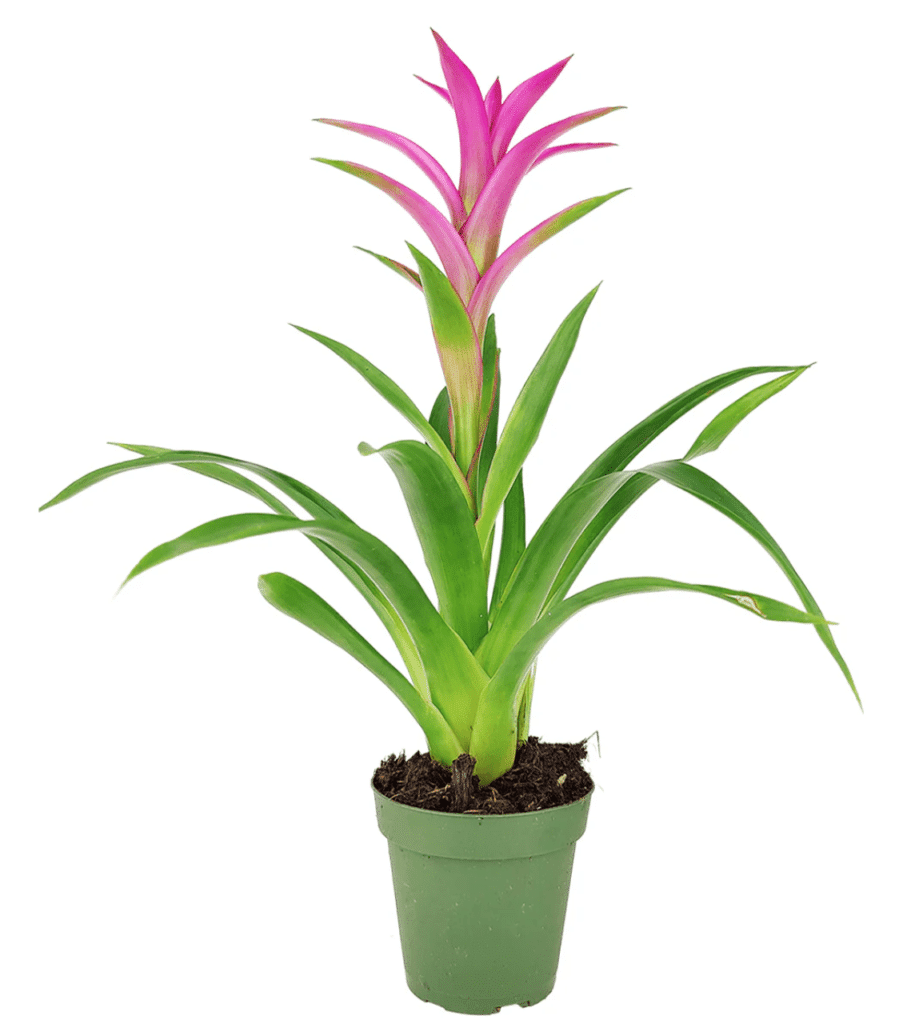
($46)
$29
“These vibrant colors in the flowers are like having bouquets all year long!”
4. Orchids
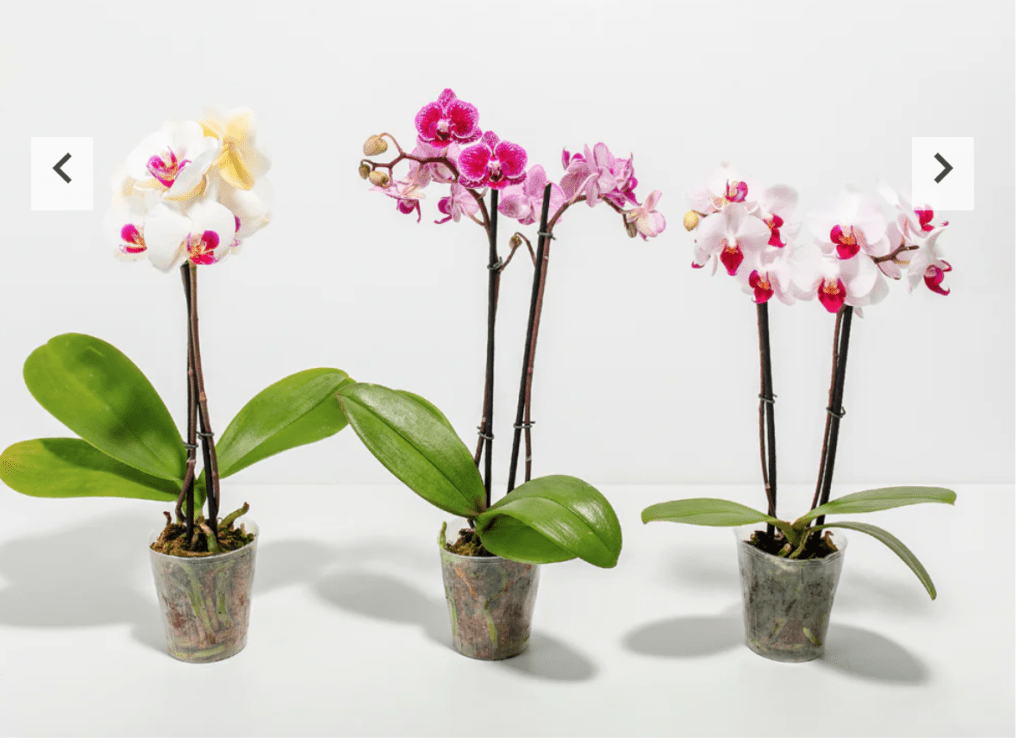
Pet safe
bright light
Grows upto 3 feet
East/west/south windows
Pet safe
Bright light
grows to 3 feet
East/west/south facing windows
The Orchid (aka Orchidaceae): This pink flowered indoor plant is a perfect addition to your bedroom, or your living room, or even your office desk. Its a member of one of the largest flowering plant families, and has blooms that range from vibrant pinks to mysterious deep purples emitting a curious but delicate fragrance that vary across species.
We’ve placed our orchids in one of our east-facing room where they receive the bright, indirect sunlight. Here, they’re styled in sleek glass pots that not only complement the delicate beauty of the orchids but also allow us to monitor the moisture levels of the roots easily.
Care tip:
- Water them once a week. Keep an eye for limp leaves, a sign of too much water or insufficient light.
- Orchids enjoy humidity, so a bathroom with a window can be ideal spots.
Propagation tip:
- Remove a keiki (baby plant) with roots, ensuring roots are at least 2 inches long.
- Plant it in a well-draining orchid mix (ideally), and keep it in bright, indirect light. Roots should establish in a few weeks
Symbolism and zodiac signs:
- The Orchid symbolizes beauty, love, and strength — apt for Virgos who appreciate detail and elegance in their surroundings.
Pros and cons

($66)
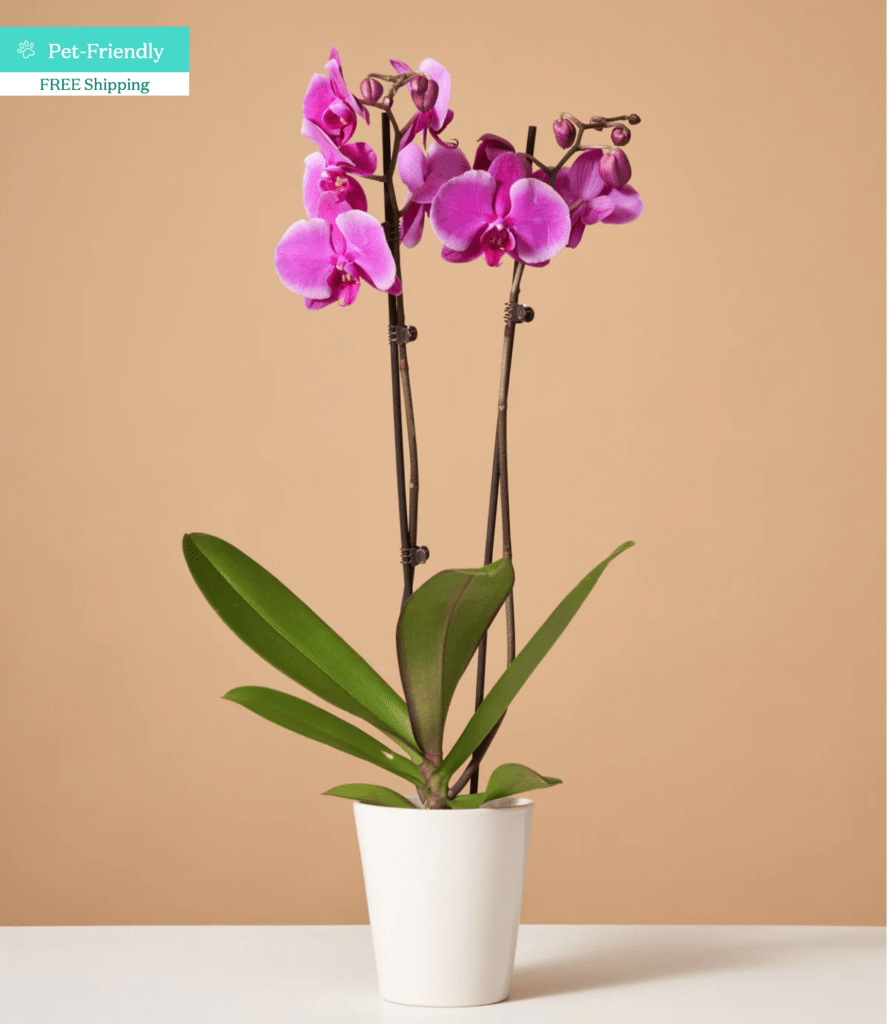
($88)
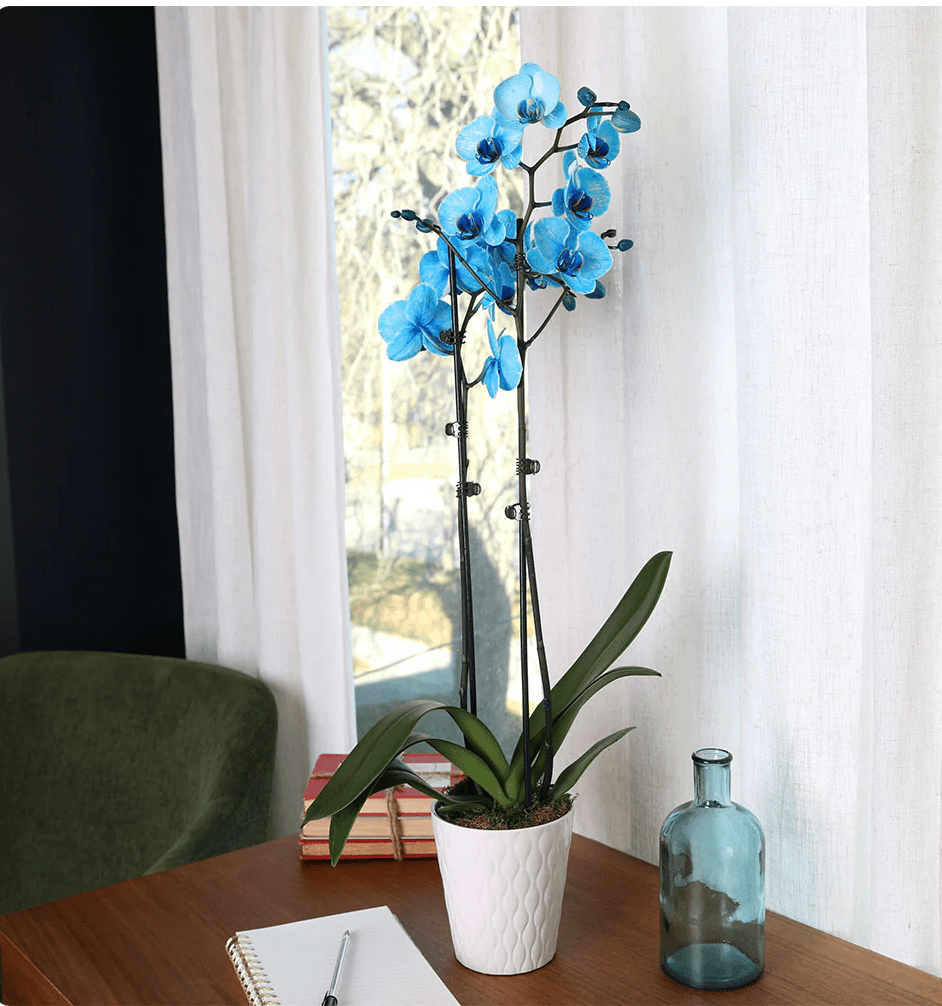
($49)
$24
“I love the elegant blooms of this orchid. It’s very easy to care for and adds a touch of elegance to my home” – Amazon customer
Also read: Pink Dragon Alocasia
Why are the leaves of my pink indoor plants turning green?
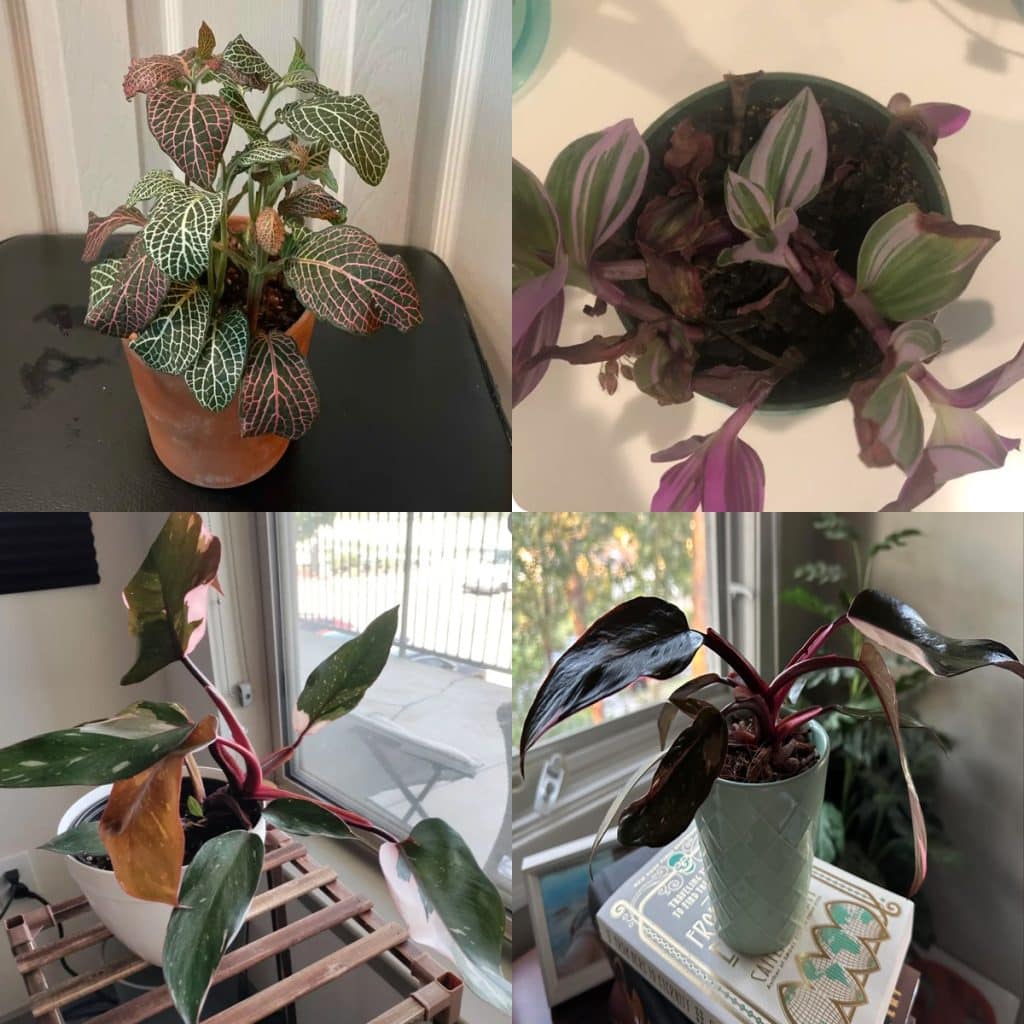
Here are the top 5 things to consider:
Understanding Why Pink Leaves Turn Green:
We’ve all been there: admiring the beautiful pink hues of a Philodendron Pink Princess or a Syngonium Neon Robusta, only to notice those blush tones slowly fading to green. It can be frustrating, especially when we’ve done everything right!
But understanding why pink plants change color is key to keeping their vibrant variegation intact. In our community household in Brooklyn, where we care for hundreds of houseplants, we’ve learned that pink leaves turning green is often a response to the plant’s environment—and thankfully, it’s something we can often correct.
How Pigmentation Works in Plants (Anthocyanins vs. Chlorophyll):
Plant coloration is a delicate balance between anthocyanins, which produce pink, red, and purple tones, and chlorophyll, which gives leaves their green color and fuels photosynthesis. While anthocyanins contribute to a plant’s unique aesthetic, they don’t assist much with energy production. So when a plant feels it’s not getting enough light or nutrients, it prioritizes survival by producing more chlorophyll—often at the expense of its pink hues – Sounds like the right priority, right?
In our experience, some pink plants are more prone to reverting than others. If a plant starts putting out green-dominant leaves, it’s a signal that something in its environment needs adjustment. The good news? By tweaking light, nutrients, and other care factors, we can often restore pink variegation over time.
The Role of Light in Maintaining Pink Coloration:
One of the biggest culprits behind pink leaves turning green is insufficient light. When pink-leaved plants don’t get enough brightness – they compensate by producing more chlorophyll, which leads to greener growth. At the same time, too much direct sunlight can scorch delicate variegation, causing stress that can also impact pigmentation.
We’ve tested different lighting setups in our Brooklyn home, and the key is bright, indirect light. Our Pink Princess Philodendrons thrive under grow lights or near east-facing windows where they get soft morning sun. If a plant starts losing its pink hues, we adjust its placement—sometimes even rotating it slightly can make a difference.
Read also: Our guide to styling pink indoor plants
Common Pink Indoor Plants Prone to Reverting to Green:
Some pink plants are naturally more resistant to reversion, while others need consistent care to maintain their pink hues. Here are a few we’ve worked with that are especially prone to turning green:
Pink Princess Philodendron – Without enough light, it reverts to green. Pruning off green-dominant leaves can help encourage pink growth.
Pink Syngonium (Arrowhead Plant) – Needs bright, indirect light; too much nitrogen can also push it towards greener foliage.
Stromanthe Triostar – Requires both high humidity and strong light to keep its pink, white, and green variegation balanced.
Tradescantia Nanouk – Fast-growing but loses its pink tones in lower light. Regular pruning and bright conditions help.
Aglaonema Pink Dalmatian – More forgiving, but it still fades under dim lighting or when overfed.
If we notice a plant reverting, we don’t panic—we troubleshoot. Adjusting lighting, managing soil and fertilizers best for pink plants, and pruning strategically can often bring pink variegation back. While some plants may never fully regain lost color, keeping conditions optimal prevents further reversion and encourages new growth with the stunning hues we love. Below are more specific recommendations to keep them thriving!
Read also: Common problems and solutions to pink houseplants
How to keep the leaves of pink indoor plants pink and thriving all year long!
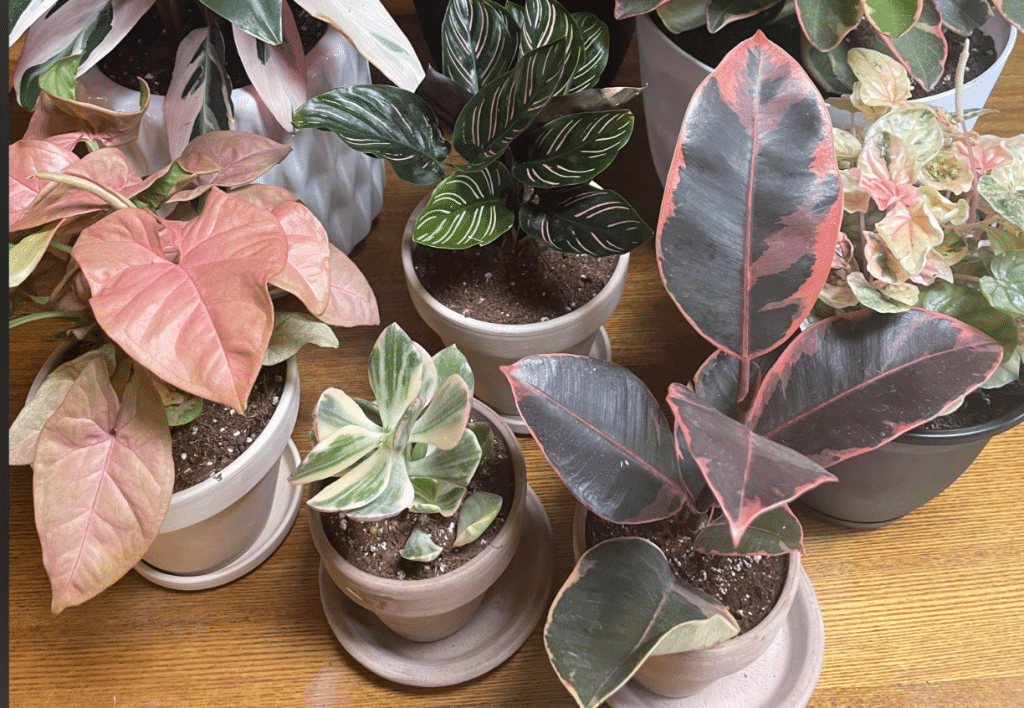
Here are the top 5 things to consider:
Optimal Lighting:
Pink plants such as Pink Chinese Evergreen and Pink Princess Philodendron need bright, indirect light to maintain their color, but not all through the day. For example, the Pink Chinese Evergreen thrives when placed near an east or west-facing window with filtered light. But importantly, rotate your plants weekly to ensure all sides receive equal light, and uneven growth and color distribution.
Watering:
Consistent watering is crucial: Calathea Rosy plants need their soil to be kept moist but not soggy. Water them when the top inch of soil feels dry. Use room temperature water to avoid shocking the roots. For plants like the Pink Anthurium — allow the soil to dry out slightly between waterings to prevent root rot.
Humidity:
Most pink houseplants thrive in higher humidity levels: the Pink Bromeliad and Calathea Rosy prefer humidity levels around 60-70%. Ofcourse a humidifier helps maintain humidity, but also a cheaper alternative is to set your plants on a tray filled with water and pebbles. Grouping plants together also helps create a more humid microenvironment.
Fertilizing:
Use a balanced, water-soluble fertilizer to keep your pink plants healthy. For example, feed your Pink Princess Philodendron and Pink Nerve Plant every 4-6 weeks during the growing season — often spring or summer time. Opt for a fertilizer with a higher potassium content to enhance the pink coloration. Always recommended to dilute the fertilizer to half strength to avoid overfeeding and potential leaf burn.
Pruning and cleaning:
Regular pruning is essential to maintain the vibrant color of pink plants like Tradescantia Pink — trim off any yellowing or damaged leaves to encourage new growth. For plants like the Rex Begonia, gently wipe the leaves with a damp cloth to remove dust. Inspect your plants regularly for pests and treat them promptly with insecticidal soap if needed.
FAQ
What are some pink indoor plants for low light conditions?
Pink princess philodendron, tradescantia, chinese evergreen, and Bromeliad are excellent pink plants for low light
How can I enhance the pink color of my houseplants
Ensure they get enough even light throughout, maintain proper humidity, rotate them often, check for overwatering signs like browning leaves, or drooping leaves, and finally clean the leaves often so they remain open to receive the light essential for photosynthesis and color production as well.
How can I decorate my home with pink houseplants??
Mix and match. We recommend either grouping pink with other pink plants, or with a contrasting dark green plant. Don’t mix pink with purple plants. Also, we love letting the pink hue trail down hanging baskets.
Do pink houseplants purify air?
Many pink plants can purify the air. For example, the Philodendron Pink Princess, like other philodendrons, can help remove toxins such as formaldehyde from the air. The color of the leaves do not correlate with whether or not they can purify the air.
Conclusion
Pink houseplants are a stunning addition to any home. When arranged well, they feel decorous like jewels draping down the hanging baskets, or terracota pots on the floor. We hope our article here has helped to get started on the journey of buying some pink houseplants. Let us know in the comments if you have any questions. If you have any tips for new parents, please put it in the comments as well and help the community out. Happy planting!

